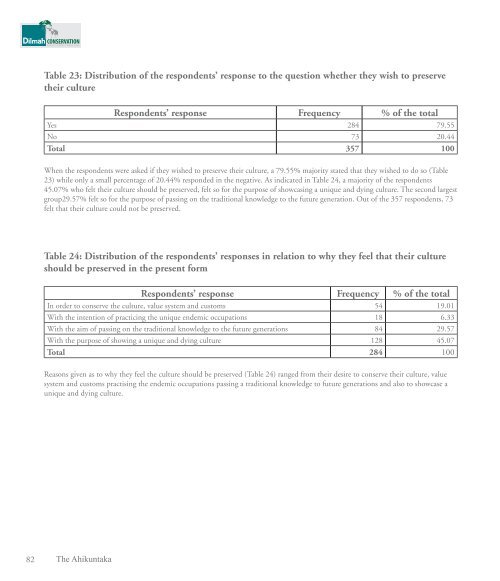The Ahikuntaka
A publication documenting the lives and livelihoods of the Ahikuntaka or gypsy community in Sri Lanka. A collection of vibrant photographs and a baseline survey on the current socio economic status of the Ahikuntaka conducted by the Colombo University complement this timely publication.
A publication documenting the lives and livelihoods of the Ahikuntaka or gypsy community in Sri Lanka. A collection of vibrant photographs and a baseline survey on the current socio economic status of the Ahikuntaka conducted by the Colombo University complement this timely publication.
Create successful ePaper yourself
Turn your PDF publications into a flip-book with our unique Google optimized e-Paper software.
www.dilmahconservation.org<br />
Table 23: Distribution of the respondents’ response to the question whether they wish to preserve<br />
their culture<br />
Respondents’ response Frequency % of the total<br />
Yes 284 79.55<br />
No 73 20.44<br />
Total 357 100<br />
When the respondents were asked if they wished to preserve their culture, a 79.55% majority stated that they wished to do so (Table<br />
23) while only a small percentage of 20.44% responded in the negative. As indicated in Table 24, a majority of the respondents<br />
45.07% who felt their culture should be preserved, felt so for the purpose of showcasing a unique and dying culture. <strong>The</strong> second largest<br />
group29.57% felt so for the purpose of passing on the traditional knowledge to the future generation. Out of the 357 respondents, 73<br />
felt that their culture could not be preserved.<br />
Table 24: Distribution of the respondents’ responses in relation to why they feel that their culture<br />
should be preserved in the present form<br />
Respondents’ response Frequency % of the total<br />
In order to conserve the culture, value system and customs 54 19.01<br />
With the intention of practicing the unique endemic occupations 18 6.33<br />
With the aim of passing on the traditional knowledge to the future generations 84 29.57<br />
With the purpose of showing a unique and dying culture 128 45.07<br />
Total 284 100<br />
Reasons given as to why they feel the culture should be preserved (Table 24) ranged from their desire to conserve their culture, value<br />
system and customs practising the endemic occupations passing a traditional knowledge to future generations and also to showcase a<br />
unique and dying culture.<br />
82 <strong>The</strong> <strong>Ahikuntaka</strong>















